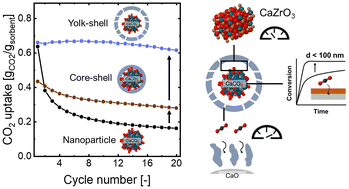Yolk–shell-type CaO-based sorbents for CO2 capture: assessing the role of nanostructuring for the stabilization of the cyclic CO2 uptake†
Abstract
Improving the cyclic CO2 uptake stability of CaO-based solid sorbents can provide a means to lower CO2 capture costs. Here, we develop nanostructured yolk(CaO)–shell(ZrO2) sorbents with a high cyclic CO2 uptake stability which outperform benchmark CaO nanoparticles after 20 cycles (0.17 gCO2 gSorbent−1) by more than 250% (0.61 gCO2 gSorbent−1), even under harsh calcination conditions (i.e. 80 vol% CO2 at 900 °C). By comparing the yolk–shell sorbents to core–shell sorbents, i.e. structures with an intimate contact between the stabilizing phase and CaO, we are able to identify the main mechanisms behind the stabilization of the CO2 uptake. While a yolk–shell architecture stabilizes the morphology of single CaO nanoparticles over repeated cycling and minimizes the contact between the yolk and shell materials, core–shell architectures lead to the formation of a thick CaZrO3-shell around CaO particles, which limits CO2 transport to unreacted CaO. Hence, yolk–shell architectures effectively delay CaZrO3 formation which in turn increases the theoretically possible CO2 uptake since CaZrO3 is CO2-capture-inert. In addition, we observe that yolk–shell architectures also improved the carbonation kinetics in both the kinetic- and diffusion-controlled regimes leading to a significantly higher cyclic CO2 uptake for yolk–shell-type sorbents.

- This article is part of the themed collections: CO2 capture and conversion, Nanoscale Most Popular 2022 Articles and 2022 Nanoscale HOT Article Collection


 Please wait while we load your content...
Please wait while we load your content...